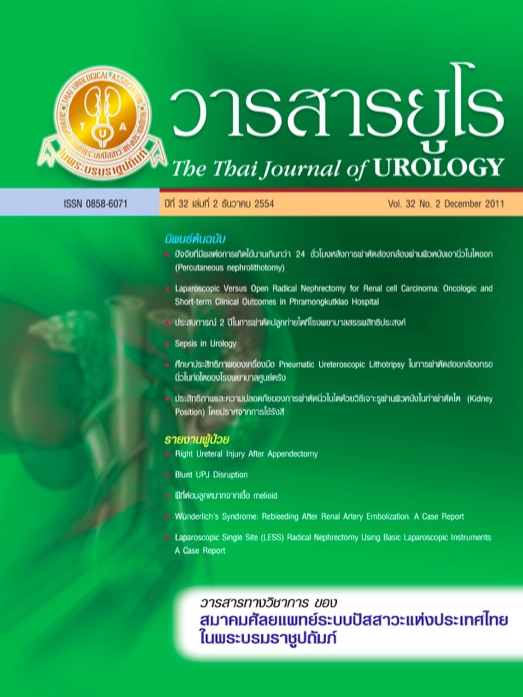Factors Associated with Persisted Fever More Than 24 Hours After Percutaneous Nephrolithotomy
Keywords:
Factors Associated, Persisted Fever, Percutaneous NephrolithotomyAbstract
Problem: Infectious complication after percutaneous nephrolithotomy (PCNL) represents a dangerous and life-threatening condition, especially when septicemia or septic shock develops. It usually occurs with persisted fever more than 24 hours after the operation.
Objective: To identify factors associated with persisted fever more than 24 hours after percutaneous nephrolithotomy.
Material and Method: One hundred and three patients underwent PCNL in 2 years in our institute. Patient characteristics, stone burden, and perioperative data were collected to analyze for association with postoperative fever using univariate analysis.
Result: Twenty-four percent of the patients developed fever more than 24 hours after the operation. In univariate analysis, significant association was shown between fever and positive immediate preoperative urine culture (p = 0.049), and between fever and intraoperative surgical complication such as bleeding and perforation of renal pelvis (p = 0.023).
Conclusion and Benefit: Positive preoperative urine culture and the presence of intraoperative surgical complication significantly increase the risk of infectious complication after PCNL. Patients with these factors should be monitored closely after the operation to identify and threat infectious complication immediately.
References
de la Rosette J, Assimos D, Desai M, Gutierrez J, Lingeman J, Scarpa R, et al. The Clinical Research Office of the Endourological Society percutaneous nephrolithotomy global study: indications, complications, and outcomes in 5803 patients. J Endourol 2011; 25(1):11-7.
Samplaski MK, Irwin BH, Desai M. Less-invasive ways to remove stones from the kidneys and ureters. Cleve Clin J Med 2009; 76:592-8.
Negrete-Pulido O, Gutierrez-Aceves J. Management of infectious complications in percutaneous nephrolithotomy. J Endourol 2009; 23(10):1757-62.
Michel MS, Trojan L, Rassweiler JJ. Complications in percutaneous nephrolithotomy. Eur Urol 2007; 51:899-906.
Draga RO, Kok ET, Sorel MR, Bosch RJ, Lock TM. Percutaneous nephrolithotomy: factors associated with fever after the first postoperative day and systemic inflammatory response syndrome. J Endourol 2009; 23(6):921-7.
Rudra A, Pal S, Acharjee A. Postoperative fever. Indian J Crit Care Med 2006; 10(4):264-72.
Mariappan P, Smith G, Bariol SV, Moussa SA, Tolley DA. Stone and pelvic urine culture and sensitivity are better than bladder urine as predictors of urosepsis following percutaneous nephrolithotomy: a prospective clinical study. J Urol 2005; 173(5):1610-4.
Sharifi Aghdas F, Akhavizadegan H, Aryanpoor A, Inanloo H, Karbakhsh M. Fever after percutaneous nephrolithotomy: contributing factors. Surg Infect 2006; 7(4):367-71.
Matlaga BR, Hodges SJ, Shah OD, Passmore L, Hart LJ, Assimos DG. Percutaneous nephrotolithotomy: predictors of length of stay. J Urol 2004; 172(4 Pt 1):1351-4.



